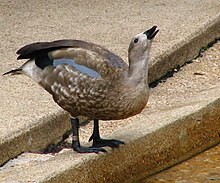Blue-winged goose
| Blue-winged goose | ||||||||||||
|---|---|---|---|---|---|---|---|---|---|---|---|---|

Blue-winged goose ( Cyanochen cyanopterus ) |
||||||||||||
| Systematics | ||||||||||||
|
||||||||||||
| Scientific name of the genus | ||||||||||||
| Cyanoches | ||||||||||||
| Bonaparte , 1856 | ||||||||||||
| Scientific name of the species | ||||||||||||
| Cyanochen cyanopterus | ||||||||||||
| ( Rüppell , 1845) |
The blue-winged goose ( Cyanochen cyanopterus , syn .: Cyanochen cyanoptera ) is a bird and belongs to the order of ducks . It is the only species in the genus of the blue-winged geese ( cyanoches ) and is assigned to the so - called half geese . These duck birds have a goose-like habit , but also have some features that are characteristic of the actual ducks .
The blue-winged goose has only a very small distribution area in the Ethiopian highlands. However, it is common there; their population is estimated at 5,000 to 15,000 individuals and is considered endangered. It is one of the most common afrotropic duck birds. A potential threat to the population can arise from a loss of habitat when human population density increases in the Ethiopian highlands.
Occurrence, habitat and diet
The blue-winged goose lives in pairs or in small family groups on plateau swamps, lakes, streams or wet meadows in the Ethiopian highlands at an altitude of 2500 to 4000 meters. Their habitat is a tropical mountain region, which has temperatures between 10 and 20 ° C throughout the year. This region is used for agriculture up to an altitude of around 2500 meters. However, it is about extensive land use with predominantly cattle farming and some arable farming. The blue-winged goose has its breeding biotopes in this habitat on river plains, lakes, damp depressions and streams that are bordered by open grasslands. Blue-winged geese are barnacles . In the dry winter time, they move to the higher alpine moor areas and breed there. In summer they move to lower altitudes and occasionally form large, loose groups there. Within these groups, they remain in their couple or in their small family associations.
Blue-winged geese graze on grassy areas in a goose-like manner. They look for food but also as ducks green delnd in the shallow waters of the waters of their habitat. They feed on grasses and herbs as well as seeds , insects and snails .
features
The blue-winged goose is a medium-sized demi-goose. Their height is 60 to 75 centimeters. The plumage is gray-brown with blue elytra over the flanks; the feet and beak are black. Both sexes have largely the same plumage color. Females are colored a bit brown to gray on the head and neck. However, the male is significantly larger than the female. Males can also be identified by an imposing posture , which they adopt relatively frequently. They pull in their necks and lay their heads on their backs. The male voice is a low, high-pitched whisper. Adult birds moult twice a year. Before brooding, parts of the small and dorsal plumage are molted. After breeding, the entire plumage is moulted.
Young birds are very similar to adult birds, but they are overall a bit darker and brown. The wings do not yet have the green mirror shine and the ceilings are still gray instead of powder blue. Downy young have a dark black-gray color on the upper side. They have an eye stripe that widens towards the back and their sides are also dark gray-black. The face of newly hatched chicks is initially straw yellow or gray-white and later changes color to gray-green. The underside of the body is gray-white. Gray-white spots can also be found on the sides of the body. Their beak and feet are black.
Reproduction
In nature, the reproduction of the blue-winged goose has not yet been adequately studied. Most of the evidence comes from captive birds.
The breeding season is triggered by rainfall and, depending on the region, falls either in the period March to May or July to December. The shallow nest is usually created on the banks of swamps and lakes. The clutch consists of four to seven cream-colored eggs, which are hatched by the female in a period of about 30 to 32 days. The chicks, which have a hatching weight of almost 60 grams, are looked after by both parents.
Attitude in Europe
The first blue-winged geese came to the zoo very late. Probably the first European zoo to show this half-goose species was the Schönbrunn zoo in 1913. The world's first breeding was achieved in 1924 by a Dutch ornithologist. The species is shown relatively rarely. Blue-winged geese, like mirror geese, are extremely aggressive during the breeding season. For this reason, breeding pairs are usually kept in individual grassy enclosures in zoos.
supporting documents
Individual evidence
- ↑ Kear, p. 399
- ↑ Kear, p. 401
- ↑ Kear, p. 401
- ↑ Kear, p. 399
- ↑ Kolbe, p. 159
- ↑ Kear, p. 401
- ↑ Kolbe, p. 160
- ↑ Kolbe, p. 160
literature
- Janet Kear (Ed.): Ducks, Geese and Swans. Oxford University Press 2005, ISBN 0-19-854645-9 .
- Hartmut Kolbe: The world's ducks. Ulmer Verlag 1999, ISBN 3-8001-7442-1
Web links
- Videos, photos and sound recordings about Cyanochen cyanopterus in the Internet Bird Collection
- Cyanochen cyanoptera inthe IUCN 2013 Red List of Threatened Species . Listed by: BirdLife International, 2012. Retrieved November 23, 2013.
